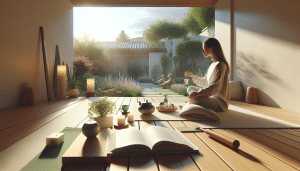Tiny Living Trends You Never Expected
Jessica White September 22, 2025
Curious about the real impact of tiny living spaces on lifestyle and wellbeing? This guide explores unexpected trends, smart organization tips, and how micro-apartments are reshaping entertainment habits—all while boosting sustainability and creativity.
Why Tiny Living Is Gaining Momentum
Tiny living is more than a housing trend; it’s a complete lifestyle shift catching on across cities and rural areas alike. People are drawn to micro-apartments, repurposed vans, and small homes for a range of reasons—from soaring urban rent prices to a desire for greater simplicity. The movement ties closely to minimalism and sustainability, encouraging residents to rethink priorities and invest only in essentials. As a result, many are choosing to downsize not out of necessity, but as an intentional way to realign life around values rather than possessions. Major cities, like New York and Tokyo, have seen a rise in micro-apartment construction designed to balance comfort with compactness, all while supporting social and environmental goals. This draws attention not only for practical reasons but also for its cultural symbolism—tiny living is seen as both progressive and responsible (Source: https://www.nytimes.com/2019/06/10/realestate/micro-apartments.html).
The appeal of these compact dwellings can be traced to more than just affordability. Many tiny home dwellers describe a greater sense of freedom. With lower costs, less clutter, and reduced maintenance, daily life can feel less stressful and more intentional. These benefits extend even further when residents adapt to shared amenities, such as communal workspaces or rooftop lounges, which are often built into newer developments. The experience isn’t always seamless, though. Letting go of old belongings or adjusting to less personal space can challenge even the most disciplined minimalists. However, advocates often cite the adaptability and problem-solving skills they gain—a unique bonus of the tiny living lifestyle. This transformation from conventional home life to micro-living isn’t just a fad; it’s shaping new expectations for home ownership, social interaction, and entertainment.
Environmental impact is another force propelling this trend. Smaller homes typically consume less energy, generate less waste, and use fewer natural resources. In cities where green space is at a premium, compact living often pairs with smart building design, incorporating features like solar panels or green roofs. This approach appeals to environmentally conscious individuals seeking both urban excitement and eco-friendly solutions. As the conversation around climate change intensifies, many see tiny living as a practical and personal way to make an impact. Recent studies back up these benefits, showing measurable reductions in water and electricity usage in micro-living communities (Source: https://www.epa.gov/greenbuilding).
Clever Organization Makes Small Spaces Livable
Smart storage is essential for anyone embracing the tiny living lifestyle. Living comfortably in fewer square feet means every inch needs a deliberate function. Design experts recommend investing in multi-purpose furniture—such as beds with built-in drawers, collapsible tables, or modular shelving units that double as room dividers. Vertical storage solutions turn unused wall space into essential real estate for books, kitchenware, and daily essentials. It’s about making the most of what you have, creatively. One useful tip for beginners is to regularly reassess needs, keeping only items that serve a clear purpose or bring joy. This ongoing process helps avoid clutter and creates a sense of order, even in the busiest, smallest homes.
Organizational hacks alone aren’t enough without a mindset to match. Many people new to small spaces find the adjustment more psychological than physical. Rather than merely downsizing, residents discover a joy in curating their environments. For families or roommates, collaboration becomes vital—everyone adapts their routines and agrees on shared responsibilities. The payoff is significant: less time spent on cleaning, easier retrieval of belongings, and a living space that feels truly tailored to its occupants. Technology also lends a hand; smart home tools and apps can track inventory, automate shopping lists, and offer reminders for maintenance or decluttering days. These tools are especially helpful when space is at a premium and every decision counts (Source: https://www.apartmenttherapy.com/storage-solutions-for-small-spaces-36823).
Natural lighting and color choices also play important roles in small-space design. Light-colored walls and minimal window dressing create a feeling of openness, while mirrors can amplify brightness and visually expand even the tiniest rooms. Adding a few well-chosen plants or textured textiles introduces warmth—crucial for spaces that might otherwise feel sterile. Small space living doesn’t have to mean sacrificing personality or comfort. Instead, it’s about making intentional choices and reimagining what’s possible within physical limits. The overall effect: a home that feels both cozy and dynamic, regardless of square footage.
How Tiny Living Changes Entertainment Habits
Entertainment looks quite different in compact homes and micro-apartments. Without a dedicated media room or sprawling living area, residents find creative ways to gather and unwind. Many tiny home enthusiasts prefer experiences over things—hosting intimate game nights, experimenting with mini projectors for movie viewing, or participating in online social events that don’t require a big crowd. Streaming services like Netflix and Spotify play a central role, letting users enjoy music and films on compact devices. Increasingly, people are building social circles around communal spaces such as shared rooftop patios or local parks, creating a sense of belonging outside the four walls of home. These new routines emphasize connection, flexibility, and quality over quantity (Source: https://www.pewresearch.org/internet/2019/09/09/mobile-technology-habits-in-the-home).
Whether it’s digital book clubs or collaborative cooking sessions, technology bridges gaps that small spaces create. Wireless speakers, lightweight tablets, and apps for virtual gatherings make entertainment not just accessible but highly customizable. In fact, many tiny home occupants report an uptick in hobbies and new interests. With less room for possessions, people often turn to creative pursuits that require minimal equipment: knitting, journaling, photography, or even online gaming with friends. This lifestyle shift fosters not only entertainment diversity but also encourages resourcefulness—cultivating skills and interests that grow alongside a simplified environment.
Artificial intelligence and automation add another dimension to how small-space dwellers find joy at home. Smart sensors adjust lighting, sound, or temperature, helping to set the perfect mood for solo relaxation or friendly hangouts. The focus is less on accumulating goods and more on maximizing experiences that fit within limited space and time. Ultimately, these changes highlight an important trend: entertainment is becoming more personalized, sustainable, and adaptable to evolving lifestyles. Tiny living turns what could be a restriction into an inspiration for new ways of socializing and winding down.
What to Expect When Downsizing—Emotionally and Practically
Downsizing puts both emotional resilience and practical skills to the test. Moving from a larger home to a compact one means letting go—not just of things, but sometimes memories and habits. Psychologists note that the process can be liberating. Living with less often brings clarity, greater focus, and even more gratitude for everyday experiences. Yet, it also requires honest self-reflection and a willingness to adapt. Those who succeed often approach the journey as an opportunity for growth. Conversations with friends and family, setting boundaries about keepsakes, and developing new comfort rituals all play roles in making the transition smooth (Source: https://www.apa.org/topics/life-transitions).
There’s a practical learning curve, too. Figuring out storage, maintaining privacy, and balancing work-from-home needs within limited square footage demands creativity and flexibility. Many people are surprised by the amount of time saved when cleaning, organizing, or simply deciding what to wear. That extra time often gets reinvested into hobbies, fitness, or building closer relationships with neighbors. Downsizing also prompts a fresh approach to purchases: items are chosen for durability, adaptability, and beauty—not just function.
One tip from long-time micro-home residents: build routines and spaces that recharge and inspire. Even in tight quarters, a cozy reading nook, a foldaway craft station, or a small plant collection can provide comfort and expression. Emotional support is equally valuable. Many communities, both online and in-person, have sprung up to help newcomers share advice and encouragement. These networks offer perspective, ideas, and reassurance, ensuring the journey into tiny living doesn’t have to be a solitary one.
Sustainability and the Broader Impact of Minimalism
Minimalism and tiny living are often linked, but their impact goes well beyond the individual. As more people adopt compact lifestyles, the demand for energy-efficient construction, green technology, and car-free neighborhoods grows. Developers and city planners respond by creating infrastructure—bike lanes, public transit, modular buildings—that support sustainability on a community scale. This gives everyone, not just tiny-home dwellers, more options for eco-conscious living. Some cities even offer financial incentives for qualifying green renovations or for choosing eco-friendly living arrangements (Source: https://www.epa.gov/smartgrowth).
Everyday minimalism also challenges cultural assumptions about success, comfort, and happiness. Moving away from consumerism means less pressure to buy and more focus on experiencing life. Instead of comparing square footage, people compare the richness of experiences and relationships. This subtle shift can have profound effects over time, influencing businesses, schools, and media to value sustainability and resourcefulness. The cultural dialogue around tiny living and minimalism is far from finished—in fact, it’s sparking new conversations about what truly matters amid global change.
For environmentally conscious individuals, even small changes accumulate. When many people choose smaller homes, greener transportation, and mindful consumption, the collective benefits are compelling. Recent reports show less residential waste, lower carbon emissions, and growing interest in renewable energy among those adopting compact living strategies. For those considering a shift, learning more about available options and real-world outcomes can help clarify whether this lifestyle fits their personal and environmental goals (Source: https://www.energystar.gov/partner_resources/residential_new).
Tiny Living Inspires Creative Design and Innovation
Tiny living has become a playground for design innovation. Architects and interior designers are embracing the challenge of creating functional, beautiful spaces within strict size limits. Concepts like flexible walls, Murphy beds, retractable staircases, and convertible seating are now mainstream. Even kitchens and bathrooms boast clever upgrades—pull-out pantries, wall-mounted racks, and fold-down counters. These creative solutions make small homes feel lively and customizable, rather than cramped. Designers often borrow ideas from boats, RVs, and capsules, merging practicality with style. The tiny living trend has, in many ways, redefined the boundaries of what ‘home’ can look and feel like (Source: https://www.archdaily.com/943137/12-tips-to-design-your-home-like-a-tiny-home).
Personalization stands at the forefront of this movement. Residents use art, modular décor, and space-saving DIY projects to make even the smallest apartment uniquely theirs. Social media is filled with inspiration—creative storage hacks, upcycled furniture, and inventive layouts spark global sharing. This collaborative energy drives rapid innovation, spreading new concepts through blogs, YouTube channels, and neighborhood meetups. The result is a blend of high style and high function rarely seen on such a small scale.
In the end, tiny living demonstrates that limitations can fuel imagination. When faced with constraints, people find unexpected solutions—and sometimes, unexpected joy. This approach is now influencing larger homes and mainstream décor, with many opting for compact, multipurpose spaces. Adaptability becomes the ultimate design goal, showing that the challenges of tiny living hold lessons for everyone about creativity, comfort, and reinvention.
References
1. The New York Times. (2019). The Rise of Micro-Apartments in Big Cities. Retrieved from https://www.nytimes.com/2019/06/10/realestate/micro-apartments.html
2. U.S. Environmental Protection Agency. (n.d.). Green Building. Retrieved from https://www.epa.gov/greenbuilding
3. Apartment Therapy. (n.d.). 12 Ingenious Storage Solutions for Small Spaces. Retrieved from https://www.apartmenttherapy.com/storage-solutions-for-small-spaces-36823
4. Pew Research Center. (2019). Mobile Technology Habits in the Home. Retrieved from https://www.pewresearch.org/internet/2019/09/09/mobile-technology-habits-in-the-home
5. American Psychological Association. (n.d.). Life Transitions. Retrieved from https://www.apa.org/topics/life-transitions
6. EPA. (n.d.). Smart Growth. Retrieved from https://www.epa.gov/smartgrowth








